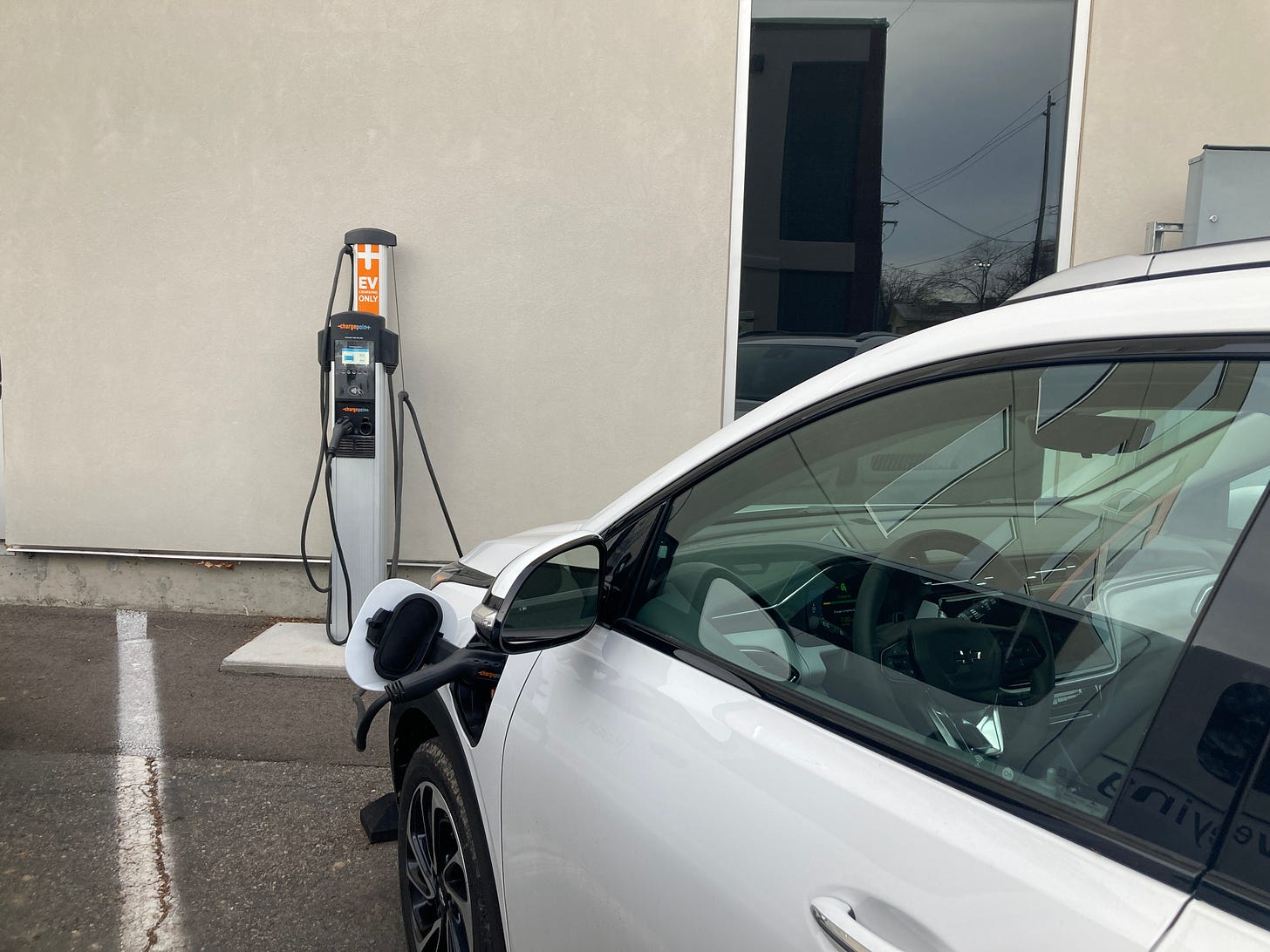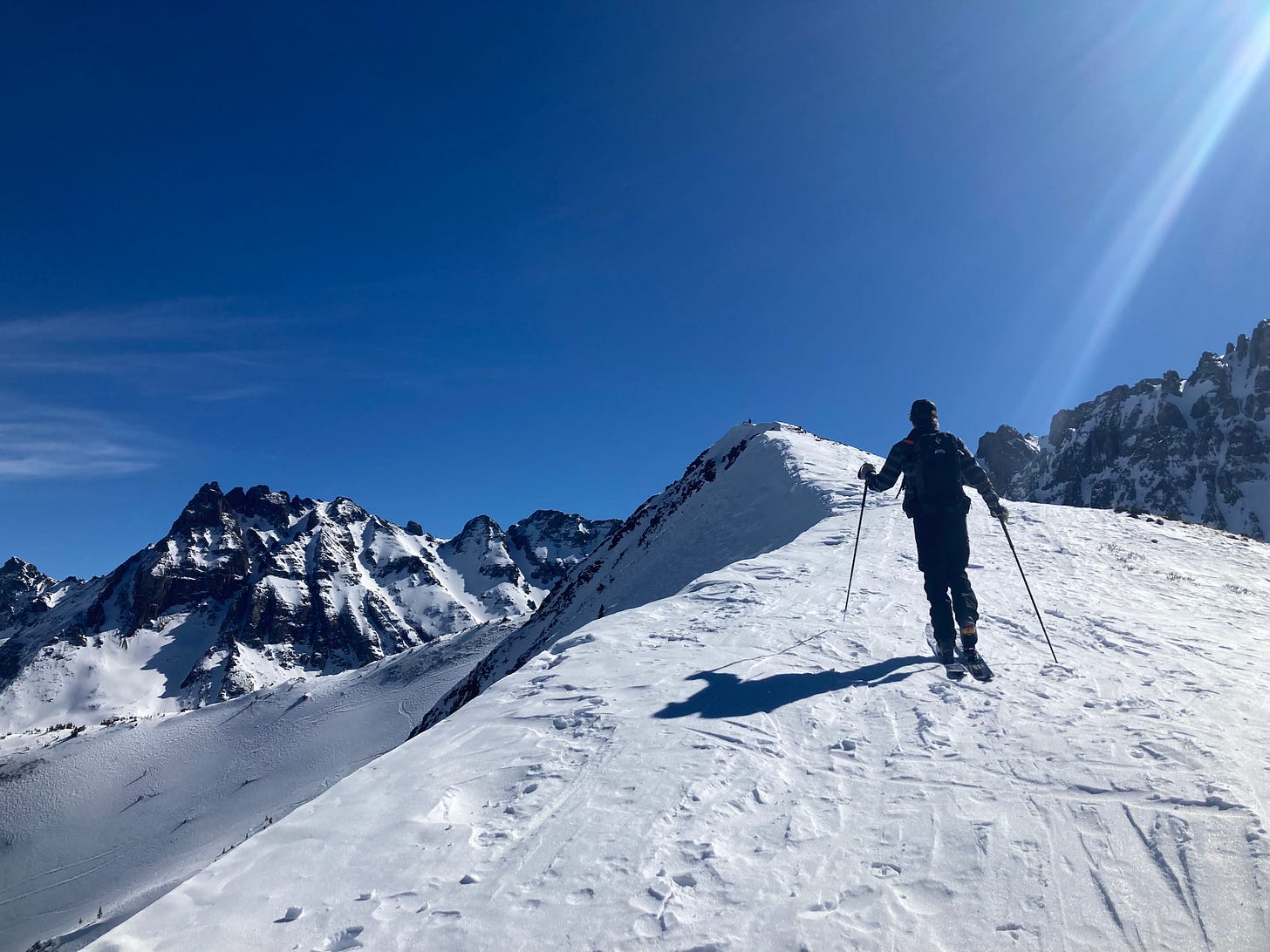Cutting my passion in half — physically — kept me from burning out
A fresh approach makes all the difference.
At the risk of sounding sappy, I believe my persistence in a career that is largely self-driven stems in part from my decision to buy a splitboard.
Hey reader,
Happy 2023 — if people still wrote personal checks, this would be the week when nearly all had a scribbled-out “22” accompanied by a sloppy pair of initials.
Today’s essay is a personal narrative about the evolution of my passion for snowboarding, and how the desire for progress carries over into work life. This week also marks the one-year birthday of Mountain Remote — for a quick trip down its rather brief memory lane, here is the first essay from January 7, 2022, about the time I almost died at Whistler Blackcomb.
I hope you enjoyed the holiday season. I spent a few cold days in Denver with family. I was eager to return home — western Colorado has been getting hammered by snow. My local resort, Powderhorn (I call it “Pillowhorn,” see photo below), has received over four feet over the past two weeks. Mind you, west coasters, before you mock that amount — this is dry, fluffy Colorado powder, of which I’ll take four feet of rather than 10 feet of Sierra cement, any day.
Here’s what my favorite side-country run looked like a couple of days ago:

In other news, my family bought an EV — a 2023 Chevy Bolt EUV (yes, it qualifies for the $7,500 federal rebate and an additional $2,000 from the state of Colorado). Yesterday morning I pulled into a Tesla charger only to embarrass myself by not being able to connect the charger to my car. I pulled away in shame in front of an actual Tesla driver who’d pulled up behind me.
Fortunately, a ChargePoint charger sat across the lot. Looks like I have a lot of trial and error ahead. Regardless, I’ve spent years researching and planning for this move, and next week’s essay will be a breakdown of my family’s decarbonization strategy to date, complete with numbers and notes on what has worked and what hasn’t.
Community Shoutouts
Welcome to the handful of new subscribers over the holidays! You’re here on emo week, but we’ll get more serious as the year matures.
Thanks to the three people who emailed me thoughts about 2022’s final essay, Should Travel Be Subsidized? It turns out the perks aren’t that hard to grasp!
Now, let’s fuel the fire.
Cutting my passion in half — physically — kept me from burning out
I first hopped on a snowboard at 15. The sport was all the rage then, in the ‘90s, and skis just didn’t cut it anymore for this Colorado kid. This decision, and the passion for snowboarding that resulted, has since played a pivotal role in every single major decision I’ve made, from where I went to college to what I do for a living, where I bought a house, and even where my wife and I were married.
In late high school, I arranged my schedule to be able to ride in the afternoons at least once per week. But it was living in Durango, Colorado, during college that turned me into the rider I wanted to be. My friends and I rode constantly, no matter the conditions. Often, we’d ride Purgatory Resort even when it hadn’t snowed in 10 days or more. Riding hard, icy, bulletproof snow is rough on the knees and is far from ideal. But it turned me into a good snowboarder, adept enough to handle the deep powder days, the terrain park, the steeps, or any other type of riding.
After moving back to Denver in 2009, I became a regular at Loveland Ski Area and also regularly returned to the spots I learned at, such as Copper Mountain, Arapahoe Basin, and others. But by 2012, I noticed my enthusiasm waning. I’d plateaued. Snowy mornings no longer filled me with the same enthusiasm as they long had, when the anticipation of that first powder turn drowned out the hassle of lousy road conditions, an impending work day, or just about anything else.
I rode only eight days during the 2011/12 season, by far my lowest total ever, including the 2002/03 season during which I broke my left femur in a car accident in early January (on the way home from one of those Purgatory days).
In short, the progression had stopped. I was riding the same lines at the same resorts, over and over. I’d become as good as I was going to get by doing that, and had seen all I was going to see. My experience as a snowboarder had begun to run in circles, and a quick trip to a new resort each winter wasn’t enough to keep the passion alive.
I’d long wanted to buy a splitboard (a snowboard that splits in half to form skis and, with “skins” attached, can be used to go uphill, then snaps back together to ride down) and learn more about foot-powered snowboarding. I’d dabbled in backcountry riding quite a bit in college, but hadn’t taken it seriously enough to make the sizeable investment in the necessary gear.
A couple more winters of stalemate riding and I realized that it was now or never. I could either hang up my boots and move into the supposedly-standard phase of adulthood where passions slide into hobbies, and then into obsolescence.
Or, I could level up my game and progress.
I bought a Jones Explorer splitboard, Spark R&D bindings, and the requisite avalanche safety gear. I signed up for an AIARE Level 1 avalanche safety course, and two years later, the Level 2. And, I began to skip the lift lines and instead head to the trailhead.
It was a steep learning curve. But getting on a splitboard opened up a whole new world of snowboarding — where I went and the lines I rode were no longer determined by a resort or season pass but by myself, my riding partners, and the omnipresent force of Mother Nature. If the avy risk on a north-east-facing slope was high on riding day, we’d ascend and ride a south-western slope. Late in the season, my partners and I researched where to head up high and hit the couloirs and steeps that were too dangerous during winter.
The adventure was renewed, and for me, the sport of snowboarding had been revolutionized. Splitboarding allowed me to take the sport into my own hands and go anywhere there were good conditions.
One of the most rewarding aspects of splitboarding is that, beyond our crew, there’s often no one else around. Perhaps we’ll encounter a few other small groups of backcountry hounds over the course of a day, but the crowds of the ski resorts are nowhere to be found.
That’s because backcountry skiing is much harder. Not skill-wise, necessarily, but in terms of effort. You only get to go down as far as you go up, and most of the day is spent ascending. When there’s no lift to drop you off at the top of the mountain, the casual weekend warrior or a tourist on vacation isn’t going to show up.
This is a sport for the dedicated, the disciplined, and the diehard. You either love it or you hate it, and you can either hack it or you can’t.
In many ways, splitboarding is parallel to self-employment. On the other hand, swap a chairlift for a boss and a marked trail for an SOP, and the result is a j-o-b. Most of the risk is gone, and with it, much of the reward.
At the risk of sounding sappy, I believe my persistence in a career that is largely self-driven stems in part from my decision to buy a splitboard. Ups and downs are unavoidable. Contracts come, contracts go. I taught myself that I have the power to reinvigorate my passion and that in doing so, the grass actually is greener (or in this case, the snow deeper) on the other side.
Mountain Remote news and further reading
Thanks to Jim for sending along this article about the (very expensive) Indonesia second-home visa, a poor guise on digital nomad visas that only the richest of the rich can afford.
I loved this article about parking lots being repurposed for housing, commerce, and other activities. I realize that means fewer places to park my new EV, but I still plan to commute primarily by e-bike once winter mellows.
Here in Colorado, the reintroduction of wolves into the wild is massively controversial. But the state has a solid blueprint, and in the end, the wolves deserve to be here more than we do (via Outside).
That’s all for now. See you next week!






